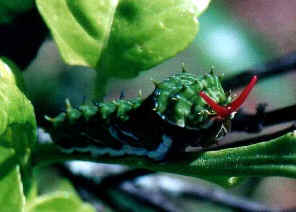|
|
All about Caterpillars
Let's get familiar with the caterpillar body structure. Basically most butterflies and moths caterpillars are long cylindrical in shape. The primarily mission is to feed and grow. It can only grow a little bigger and have to moult. Most butterflies will moult four to five time then will turn into a pupa.

Head - One the caterpillar head there are six simple eyes, or known as stemmata or ocelli, on each side. Caterpillar does have antenna although very small and hard to be seen. There is always the inverted 'Y' shape on its face. It is the mouthpart, include the mandible, maxillae and palp similar to the chewing mouthpart of grasshopper. At the bottom of the head there is the spinneret which produces the silken thread. Not many caterpillars have this special glandular osmeterium. When disturbed, the caterpillar display the osmeterium from it head, which is brightly red colour and quite scarily. Together there is the pungent smelling and strange enough to drive the predator away.
Thorax - The thorax is three segmented, each has a pair of tharacic legs. There is a pair of spiracles on the first thorax segment but not on the other two segment.
Abdomen - There are the segments in the abdomen. There are the spiracles on each side of the first eight segments. Segment three to six each have a pair of ventral prolegs. The last segment also has the similar prolegs known as anal prolegs. Each proleg has a crochets which help in walking and holding objects. When walking on he smooth surface, the crochets act as suction cups. Some caterpillar bodies are smooth but most are with minute spines, called spinules.


- Orchard Swallowtail Caterpillar, last instar Wanderer Caterpillar, last instar
How the caterpillars run away from their predators? Why we sometimes see a Looper Caterpillar hanging from a silk in mid-air?
Most caterpillars move slowly. If they have to run away from their predators, the most effective way is to drop onto the ground. However, most caterpillars, beside just dropping, they evolved different ways to enhance their way of escape.
- Looper Caterpillar that Bungee-Jumps


- We find that for the Looper caterpillars that live on trees, they use a very smart way to escape from predators. Like the Looper in above photos, when disturbed, it drop to the ground and disappear form predator's eye-sight. When we check carefully, instead of just doing a simple jump, the Looper made a Bungee Jump. It jumped with a safety line, the silk, attached to its body. After jumping, it was hanging in the mid-air. After a minute or so, it climbed via the silk back to the same place easily.
- There is a lot of advantages on this Bungee-Jump. If the caterpillar just drop to the ground, the ground is sure not a safe place for the caterpillar. Also it is very hard for the caterpillar to climb back up to the tree. The worst is, if it drop to the ground, the predator may follow and find it.
- Next time when you see a Looper, try to induce a Bungee Jump. This is fun to watch.
- Caterpillar that drops and curves


- For some other caterpillars, such as the one in the above pictures, they are not living on a tree. They live on grass. The Bungee Jump escape methods may not be practical. Instead, this caterpillar drop to the ground and curve its body into a round shape.
- The curved caterpillar looked completely different so the predator may not recognize it on the ground. Later when the danger has gone, it is not too difficult for the caterpillar to climb back onto the grass.
Here we would like to thank Don Herbison-Evans for his kindly advices on the identity of some caterpillars and adults in our web site. His Australian Caterpillars web site is our major reference.
